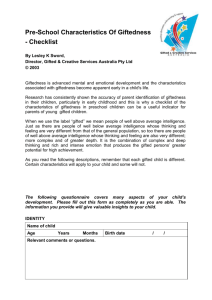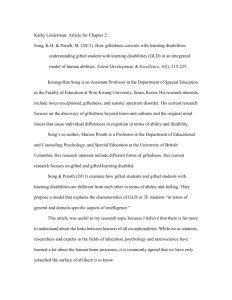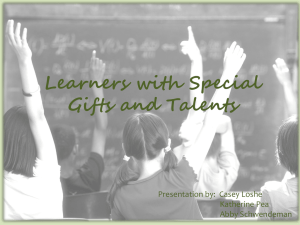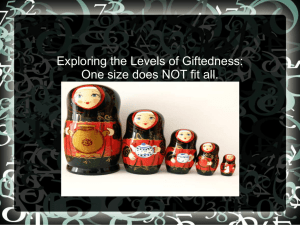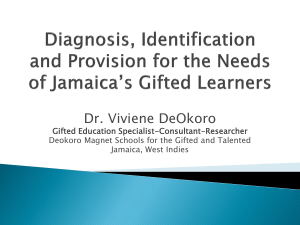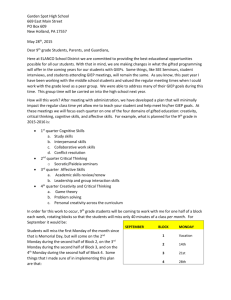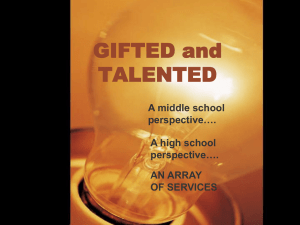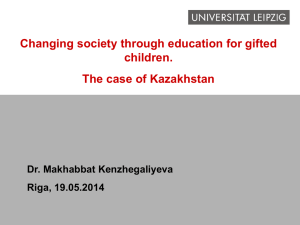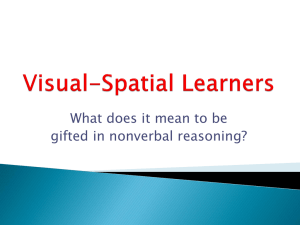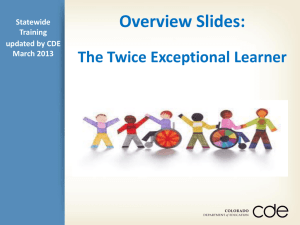Neshaminy School District Gifted Education Program
advertisement
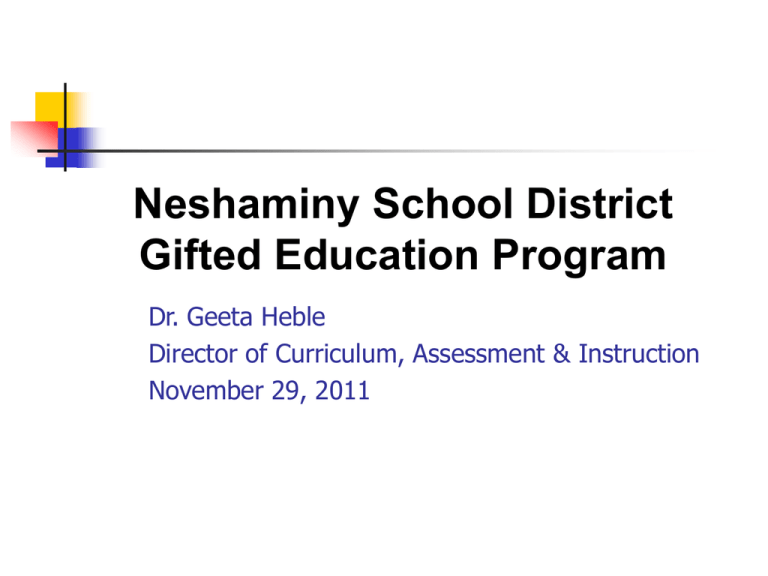
Neshaminy School District Gifted Education Program Dr. Geeta Heble Director of Curriculum, Assessment & Instruction November 29, 2011 Overview Identification Current status Staff Delivery of instruction Curriculum Framework for teaching/learning Curriculum – elementary, middle, high Looking to the future Questions Identification What Makes a Child “Gifted?” Definitions of Giftedness “Asynchronous development in which advanced cognitive abilities and heightened intensity combine to create inner experiences and awareness that are qualitatively different than the norm” (Columbus Group). “Youth who give evidence of high performance capability in areas such as intellectual, creative, artistic, or leadership capacity, or in some specific academic fields, and who require services or activities not ordinarily provided by the school to develop such capabilities” (Marland). Joseph Renzulli’s Three Ring Model of Giftedness 1 – Above average ability 2 - High Level of Creativity 3 – High Level of Task Commitment Bright vs. Gifted Learners Knows the answers Is interested Is attentive Has good ideas Works hard Answers the questions Listens with interest Learns with ease Asks the questions Is highly curious Has seemingly “silly” ideas Plays around, yet tests well Discusses in detail, elaborates beyond the answer Shows strong feelings and opinions Some Possible Characteristics of a Child Exhibiting Evidence of Giftedness Advanced vocabulary for his/her age Ability to learn new things very quickly Strong memory Ability and preference for thinking on a higher, more abstract level than peers Sophisticated sense of humor Ability to see connections between apparently unlike things and to transfer concepts to new situations Some Additional Possible Characteristics of a Child Exhibiting Evidence of Giftedness Better able to construct and handle abstractions. Often pick up and interpret nonverbal cues and can draw inferences that other children need to have spelled out for them. Take less for granted, seeking the "hows" and "whys." Can work independently at an earlier age and can concentrate for longer periods. Some Additional Possible Characteristics of a Child Exhibiting Evidence of Giftedness Often have seemingly boundless energy, which sometimes leads to a misdiagnosis of hyperactivity. Usually respond and relate well to parents, teachers, and other adults. Like to learn new things, are willing to examine the unusual, and are highly inquisitive. Tackle tasks and problems in a well-organized, goaldirected, and efficient manner. Exhibit an intrinsic motivation to learn, find out, or explore and are often very persistent. "I'd rather do it myself" is a common attitude Myths About Students with Giftedness Gifted students are like cream that rises to the top in a classroom Gifted students do not have learning disabilities Gifted students are so smart they do fine with or without special programs Giftedness, when it occurs, is generally global. Gifted children are glowing with psychological health. Identification Process Universal screening Multiple criteria IOWAS in Grade 1 COGATS in Grade 2 Achievement a year or more above grade level on nationally normed and validated tests Rate of acquisition Demonstrated achievement evidenced by excellent products, portfolio, research as well as criterion referenced team judgment Early skill development – early and measured use of high level thinking skills, academic creativity, leadership skill, intense academic interest areas, foreign language aptitude, communication skills or technology expertise WISC IV – core subtest scores in vocabulary, matrix reasoning, coding, etc. Standard Scores Very Superior: > 130 Superior: 120-129 High Average: 110 – 120 Average: 90-109 Low Average: 80-89 Borderline: 70- 79 Very Low: <69 Our “Magic” Number? Full Scale IQ or General Ability Index Score of 126 (brings possible score up to 130 with confidence interval) General Ability Index (GAI) is a score which is derived from only the Verbal Comprehension and Perceptual Reasoning Composites and DOES NOT take into account Working Memory and Processing Speed. Gifted Evaluation Scale, 3rd Edition Subscales: Intellectual Creativity Specific Academic Aptitude Leadership Ability Performing and Visual Arts Yields Standard Scores GIEP Gifted Individual Education Program Present Levels of Educational Performance Goals and Outcomes Specially Designed Instruction Dates Objective Criteria Assessment Procedures Timelines GIEP Team Participants Support Services NORA Student Relocations The Teaching/Learning Framework for Gifted Students Approach is inquiry-based and uses problemsolving strategies Problems are designed to ensure that students gain knowledge, preferably integrated from many disciplines Projects help students to learn a set of important concepts, ideas and techniques Problems are authentic (real world) and hold intrinsic interest or importance The Teaching/Learning Framework for Gifted Students contd. Seven essentials for problem-based learning 1. A need to know 2. A driving question 3. Student voice and choice 4. 21st century skills 5. Inquiry and innovation 6. Descriptive feedback and revision 7. A publicly presented product from J. Larmer and R. Mergendoller in Educational Leadership The Teaching/Learning Framework for Gifted Students contd. Meaningful Work Pre-assessment – ability and interest Student choice of assignments from a menu of options that extend knowledge, expand critical thinking and promote creativity Modifications for Gifted Students Ensuring advanced content Working with complex concepts Demonstrating interdisciplinary connections Practicing good reasoning and habits of mind and self-directed action Debating and discussing conflicting points of view Elementary AE Curriculum Content Focus by marking period Social studies & language arts (I) Science (II) Interdisciplinary (III) Independent Study (IV) INTERACTIVE NOTEBOOK Elementary AE Curriculum contd. Skill focus by marking period Writing and presentation (I) Research (II) Creativity (III) Integration of skills – higher levels of Bloom’s taxonomy- analyze, synthesize, evaluate, create (IV) Elementary AE Curriculum contd. Framework for Instruction Introductory activity – Critical Thinking Challenge (510 mins.) Inquiry-based learning organized by content (50 mins.) Application of problem-solving strategies and mathematical reasoning (50 mins.) Closing activity – Global awareness and current events (5-10 mins.) Elementary AE Curriculum Teacher Responsibility Providing explicit instruction with clearly identified learning targets and assessment rubrics Modeling Guiding student choice; keeping activities open-ended Providing appropriate learning environment and opportunities for collaborative and individual effort Monitoring student growth and conferencing to provide descriptive feedback on performance Student Responsibility Searching Solving Creating Sharing Middle School AE Curriculum Curriculum Strands Middle School AE Curriculum Curriculum Strands High School AE Curriculum 9th grade – English 10th grade – Chemistry 11th grade - Social Studies 12th grade - English Program Improvements Training in writing GIEP’s Opportunities for collaboration Support for professional learning at conferences on topics to challenge gifted learners Regularly scheduled meetings Substitute coverage during teacher absences Access to technology tools Looking to the Future Gifted Program Committee to assess what the program looks like at each level and to make recommendations for a well articulated program from grades 1 - 12. Communication through newsletters (January and June) Expanding the use of technology tools to increase student engagement and prepare them for the 21st century world QUESTIONS???
